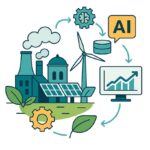LCA Data Supply Services for Waste-Specific Life Cycle Inventory: For Open Burning of Municipal and E-Waste for Developing Countries
Our Life Cycle Inventory (LCI) data service supply for open waste burning of municipal solid waste and Waste Electrical and Electronic Equipment (WEEE; Electronic waste or e-waste) in developing countries are created to conduct Life Cycle (LCA) studies or for understanding their emissions factors/inventories in chich, such data does not exist in commercial databases. We estimate an inventory for open burning of waste management practices in developing countries with our LCI model that focuses on releasing pollutants from specific wastes. This model estimates the emission factors of particular wastes when burned in an open site without cleaning the combustion gases.
The functional unit is still a 1 kg waste entry. Emissions to the atmosphere are considered, including the total particulate mass. Therefore, emissions from waste are calculated for three particles (PM>10; PM2.5-10; PM<2.5). Heavy metals and other components are also categorized.
The open burning estimation of emission factors is waste-specific. The composition of the elemental waste has a significant influence on the emissions inventoried. Sometimes open burning is used to isolate recyclable materials from a composite material, such as the burning of copper insulating wires or printed wiring boards. In this case, the targeted recyclable material is removed from the combusted residue. As far as iron, aluminum, and copper are concerned, we specify the recycling rates of these metals from waste residues. Recycled fractions are then subtracted before determining releases to land. The rates are linked only to the metallic parts of these components, etc. If any other materials than iron, aluminum, or copper are removed, it’s advised that recycled amounts are already excluded in the waste composition definition; otherwise, they would cause soil emissions.
A specific quantity of waste for the total mass of particles emitted into the air is derived from the specific masses of waste transferred into the air. For each element, we assume oxidation and an increase according to the weight. The oxides of the following elements emitted to air are summed up to obtain total particulate mass: boron, chlorine, bromine, iodine, silver, arsenic, barium, cadmium, cobalt, chromium, copper, mercury, manganese, nickel, lead, antimony, selenium, tin, vanadium, zinc, beryllium, scandium, strontium, titanium, thallium, tungsten, silicon, iron, calcium, aluminum, potassium, and magnesium, etc. Continuous process-specific CO and CH4 emissions are inventoried for each kilogram of waste, regardless of composition. Carbon dioxide generation from waste is corrected by the carbon content of CO and CH4.
The model has several parameters which characterize the open combustion process. They are more associated with a specific site than a specific waste. We choose if soil pollutants are released to industrial soil or agricultural soil based on customer information. An impact assessment methodology indicates that agricultural soils can lead to more significant human health burdens. The emission medium for agricultural soils can also be estimated. For recycling, in the case of iron, aluminum, and copper, the user may specify the quantity of metal in the waste to be recycled from combustion residues. Complete recycling means that the component of the metal form is separated. The recycling rate defines the maximum quantity of loose recyclable metal that is recycled. The maximum amount of non-ferrous metals that can be recycled is included in the waste definition. We can determine recycling rates for iron, aluminum and copper based on customer information, our surveys where possible from government publications and websites, and technical reports.
We compile different sets of input parameters supplied by our customers or examined for our purposes. Values from different sites and records are listed in our model. A particular set can then be chosen easily by providing us with the status of each open combustion process site. Therefore, we can support multiple site inventories in different regions and countries.
Different climatic conditions are considered to estimate those emissions (emissions per 1 kg of waste composition or type. e.g., copper, iron, electronic components, cables, organic waste, plastic, paper, etc.). We focus on emission factors from specific waste components, including municipal solid waste and Waste Electrical and Electronic Equipment (WEEE; e-waste; electronic waste).
Our clients need to provide us with the input parameters required for the estimation. The parameters are usually simple and, in most cases, can be easily obtained. These parameters can usually be obtained from municipalities, waste management experts, and engineers of a specific city or country, literature, or national technical reports. Based on the client’s request, we use them as input parameters to estimate a complete emissions inventory of waste open burning for municipal waste, e-waste, or both. We estimate those emissions to all mediums, including emissions to water, air, and soil. If our clients cannot provide us with those parameters and information of the landfill sites, we do the service at our end. We investigate the situation in the target city or country and do our best to obtain those parameters and information for extra fees.
Our clients need to provide us with the input parameters required for the estimation. The parameters are usually simple and, in most cases, can be easily obtained. These parameters can usually be obtained from municipalities, waste management experts, and engineers of a specific city or country, literature, or national technical reports. Based on the client’s request, we use them as input parameters to estimate a complete emissions inventory of waste open burning for municipal waste, e-waste, or both. We estimate those emissions to all mediums, including emissions to water, air, and soil. If our clients cannot provide us with those parameters and information of the landfill sites, we do the service at our end. We investigate the situation in the target city or country and do our best to obtain those parameters and information for extra fees.











